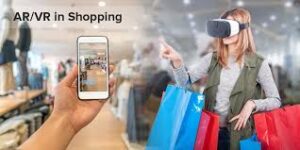What Is AR Shopping?
AR shopping, or augmented reality shopping, blends the digital and physical worlds to create immersive retail experiences. Using your smartphone, tablet, or AR glasses, you can overlay virtual products—like clothes, furniture, or makeup—onto your real-world environment. Think of it as a magic mirror for online shopping. For example, apps like AR Beauty Try-On let you test lipstick shades without smudging your screen.
Unlike virtual reality (VR), which plops you into a fully digital world, AR enhances your reality. It’s like Pokémon Go, but instead of catching Pikachu, you’re catching deals. Retail giants like IKEA and Sephora are already using Augmented Reality shopping to let customers visualize products in real time, making impulse buys way more tempting.
AR shopping, short for Augmented Reality shopping, is like having a magic wand for retail. It uses your smartphone, tablet, or AR glasses to overlay virtual products—like clothes, furniture, or makeup—onto your real-world environment. Imagine pointing your phone at your living room and seeing a virtual couch pop up, perfectly scaled to fit your space. Or trying on a pair of sunglasses through a virtual try-on without leaving your couch. Cool, right?
Unlike virtual reality (VR), which traps you in a digital world, augmented reality retail enhances your reality. Think Pokémon Go, but instead of chasing Pikachu, you’re hunting deals. Big brands like IKEA and Sephora use augmented reality retail to let you visualize products in real time, making online shopping more interactive and way less risky. It’s the future of retail, and it’s here to make impulse buys a whole lot smarter!
Why Augmented Reality shopping Matters
In a world where online shopping is king, augmented reality retail adds a sprinkle of magic to the experience. It bridges the gap between the tactile joy of in-store shopping and the convenience of e-commerce. No more guessing if that neon green sofa will clash with your curtains—AR lets you see it in your living room before you click “buy.”
Boosting Buyer Confidence
Augmented reality retail reduces the “will it look good?” anxiety. Studies show that 75% of consumer-facing brands will adopt AR by 2027 to boost confidence and cut returns. When you can virtually try before you buy, you’re less likely to send that impulse purchase back.
Engaging Shoppers
AR shopping is like giving shoppers a toy to play with. It’s interactive, fun, and keeps them on your site longer. Longer dwell time? That’s SEO gold and a win for conversions.
Benefits of Augmented Reality shopping
Augmented Reality shopping isn’t just cool—it’s practical. Here’s why it’s winning hearts (and wallets):
- Enhanced Visualization: See products in your space or on your body before buying.
- Fewer Returns: Accurate previews mean fewer “oops” moments.
- Personalized Experiences: AR tailors recommendations based on your preferences.
- Fun Factor: It’s like playing a video game, but you end up with a new rug.
- Accessibility: Shop from anywhere, anytime, with just a phone.
Retailers love it too. AR shopping increases conversion rates by up to 40%, according to our retail stats page. It’s a win-win!
Read more: Best Sustainable travel credit cards: Insights 2025
Augmented Reality shopping Trends to Watch
Augmented Reality shopping is evolving faster than a TikTok dance trend. Here are the hottest developments:
Social Commerce Integration
Platforms like Instagram and Snapchat are embedding Augmented Reality shopping into their apps. You can try on sunglasses from an ad and buy them without leaving the app. Talk about instant gratification!
AI-Powered AR
Artificial intelligence is making Augmented Reality shopping smarter. AI analyzes your style to suggest products, like a virtual personal shopper. Check out our AI in retail guide for more.

AR in Physical Stores
Brick-and-mortar stores are getting in on the fun. Mirrors in dressing rooms now use AR to show you different outfits without changing. It’s like having a stylist in your pocket.
| Trend | Description | Example |
|---|---|---|
| Social AR | AR filters on social platforms. | Instagram’s AR try-on ads. |
| AI + AR | Personalized product suggestions. | Sephora’s Virtual Artist. |
| In-Store AR | AR mirrors in retail stores. | Zara’s AR dressing rooms. |
Augmented Reality shopping for All Ages
Augmented Reality shopping isn’t just for tech-savvy Gen Z. It’s for everyone! Here’s how it appeals across age groups:
Teens (13–18)
Teens love Augmented Reality shopping for its gamified vibe. They’re trying on virtual sneakers or makeup filters on Snapchat, sharing looks with friends, and buying what’s hot.
Young Adults (19–34)
Millennials and Gen Z adults use AR to make smart purchases. They’re visualizing furniture or testing tech gadgets, ensuring every buy is Instagram-worthy.
Middle-Aged Shoppers (35–54)
This group values convenience.Augmented Reality shopping lets them preview home decor or clothing without dragging kids to the mall. It’s a time-saver!
Seniors (55+)
Grandparents are getting in on AR too! Easy-to-use apps help them try glasses or furniture, making online shopping less intimidating. Plus, it’s fun!
Challenges in Augmented Reality shopping
AR shopping isn’t all rainbows and virtual unicorns. There are hurdles to overcome:
- Tech Barriers: Not everyone has a 5G phone or AR glasses.
- Learning Curve: Some users find AR apps tricky to navigate.
- Cost: Developing AR tools is pricey for retailers.
- Privacy Concerns: AR apps often need camera access, raising data security questions.
Despite these, brands are working hard to make AR shopping accessible and secure. Check out our retail tech challenges post for more insights.
Future of AR Shopping
The future of AR shopping is brighter than a neon billboard. Here’s what’s coming:
AR Glasses Take Over
Forget phones—AR glasses will let you shop hands-free. Imagine walking through a store and seeing product details pop up in your field of vision.
Virtual Showrooms
Brands will create fully immersive AR showrooms, where you can “walk” through a store from your couch. It’s like teleporting to Fifth Avenue!
Sustainability Boost
AR shopping could reduce returns, cutting waste and emissions. It’s retail with a conscience. Learn more about sustainable retail.
Wrapping Up: AR Shopping Is Here to Stay
AR shopping is transforming retail, making it more interactive, personalized, and fun for all ages. From trying on virtual outfits to placing furniture in your home, it’s like having a superpower for shopping. Despite challenges like tech barriers, the future looks bright with AR glasses and virtual showrooms on the horizon. Whether you’re a teen chasing trends or a senior seeking convenience, AR shopping has something for you. Ready to dive in? Explore AR apps today and shop the future! Leave your thoughts in the comments!
Advantages of AR Shopping
AR shopping is revolutionizing retail by blending digital wizardry with real-world convenience. Here’s why it’s a game-changer for shoppers and retailers alike:
- Enhanced Visualization
AR shopping lets you “try before you buy” in a virtual setting. Want to see how a sofa fits in your living room or how those sneakers look on your feet? AR overlays products onto your real-world environment via your phone or AR glasses. No more guessing games—see it, love it, buy it! - Fewer Returns
By offering accurate previews, AR shopping slashes the chances of buyer’s remorse. You can check if that neon lamp clashes with your decor before it arrives. Studies suggest AR reduces return rates by up to 25%, saving you hassle and retailers money. - Personalized Experiences
AR shopping apps use AI to tailor recommendations to your style. It’s like having a personal shopper who knows your vibe. Whether you’re into minimalist furniture or bold makeup, AR curates options that scream “you.” - Fun and Engaging
Let’s be real—AR shopping is like playing a video game where the prize is a new wardrobe. Swiping through virtual try-ons or placing furniture in your space is interactive and addictive, keeping you hooked and boosting retailer conversions. - Accessibility for All
Shop from your couch, car, or coffee shop—AR shopping only needs a smartphone. It’s a boon for busy parents, seniors, or anyone who dreads crowded malls. Plus, it’s inclusive, with apps designed for all ages and tech comfort levels. - Boosts Confidence
AR eliminates the “will it work?” worry. Whether it’s testing lipstick shades or visualizing a TV on your wall, you make informed choices. This confidence translates to happier purchases and fewer post-buy regrets. - Eco-Friendly Potential
Fewer returns mean less shipping, packaging, and waste. AR shopping supports sustainability by helping you buy right the first time, reducing the environmental footprint of e-commerce.

Bonus for Retailers
Retailers see up to 40% higher conversion rates with AR shopping, as customers linger longer and buy more. It’s a win-win—shoppers get a fun experience, and brands get loyal fans.
Want to dive deeper into AR shopping trends? Check out <a href=”/ar-shopping-trends”>our trends guide</a> or share your favorite AR shopping moment in the comments!
FAQs About AR Shopping
1. What devices do I need for AR shopping?
You need a smartphone or tablet with a camera and AR-capable apps. Some brands support AR glasses, but they’re not mandatory. Most AR shopping apps are free and work on iOS or Android.
2. Is AR shopping secure?
AR shopping is generally safe, but apps may request camera or location access. Stick to reputable retailers and check privacy policies to protect your data.
3. Can AR shopping save money?
Yes! AR shopping reduces returns by letting you preview products, saving on shipping costs. Some apps also offer exclusive AR-based discounts.
4. How accurate is AR shopping?
AR shopping is highly accurate for visualization, though lighting or device quality can affect results. Top apps use AI to ensure near-perfect previews.
5. Which brands use AR shopping?
Big names like IKEA, Sephora, and Nike offer AR shopping. Many fashion and home decor brands are jumping on board, so check your favorite store’s app!


Эта статья предлагает живое освещение актуальной темы с множеством интересных фактов. Мы рассмотрим ключевые моменты, которые делают данную тему важной и актуальной. Подготовьтесь к насыщенному путешествию по неизвестным аспектам и узнайте больше о значимых событиях.
Выяснить больше – https://vyvod-iz-zapoya-1.ru/